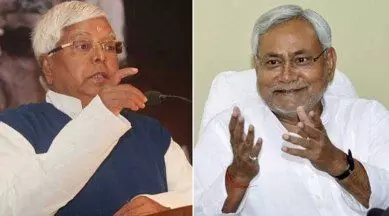When Nitish and Lalu personally delivered press releases

Lalu Yadav, Nitish Kumar
This is a story about the relationships between Chief Ministers in different Indian states and the media, with a particular focus on Bihar’s two dominant socialist leaders over the past thirty years — Nitish Kumar and Lalu Prasad Yadav.
Lalu, during his early political days, would ride his Vespa scooter to Pradeep Dainik on Buddha Marg, The Searchlight, Aryavarta, and The Indian Nation on Fraser Road. He would personally hand over handwritten press releases to editors, always with a humble request. He also made it a point to visit PTI and UNI, and never missed All India Radio, where he would ensure his news made it to Arun Kumar Verma, the editor. He believed people in Chapra tuned in to the evening news, so it had to be there. He maintained this practice even as a Member of Parliament — and continued, as Chief Minister, to visit offices along with the Director of Public Relations.
If a reporter wrote anything even mildly critical about him, he would call the owner and have the journalist fired. A particular reporter from a national English daily was a favorite of his. When the beat of this reporter was changed by an editor, Lalu called the industrialist-owner in Delhi, not only got the beat reinstated but also had the local editor transferred out of Patna.
Nitish Kumar, during his college days, was friends with Arun Sinha, who later became the chief correspondent of a newly launched daily in Patna. When Nitish broke away from Lalu and formed the Samata Party, he too would personally deliver press releases to newspaper offices. Sometimes they were published, but often they ended up in the trash for lack of space. On one occasion, while handing over a release, Nitish pleaded with the chief reporter, “At least print a little.” The reply was a scolding: “Should we print your statement every single day?”
Today, that same newspaper carries Nitish Kumar’s photo daily, without any requests or lobbying.
His government machinery now works proactively — anyone who steps out of line sees their advertisement revenue cut or completely stopped.
Before these two, former Chief Minister Jagannath Mishra introduced the Bihar Press Bill in 1982, which had to be withdrawn after nationwide protests. Ironically, Jagannath himself had once been a correspondent for Aryavarta in Muzaffarpur and later became Chief Minister. He even launched the Patliputra Times, managed by his sons, and brought in the latest printing machines.
As Chief Minister, Jagannath held press conferences daily at 5 PM, even if returning from tours. These were often hosted at his residence. He would dictate reports over the phone himself, even from Bihar Bhavan in Delhi — especially when Bihar submitted demands to the Planning Commission. He knew the deadlines of every major publication.
There was once even a Chief Minister who derogatorily referred to journalists as "freeloaders". In a press conference, he taunted them: "These freeloaders keep writing nonsense about us."
There’s a well-known photo of Bindeshwari Dubey, eating a chicken leg, published on the front page of a Patna daily. The next day, the photographer was summoned, and the owner of the paper was furious. Dubey himself had once launched a daily called Amrit Varsha.
Earlier, the Chief Minister’s residence didn’t have a permanent Public Relations office. Now, however, Nitish Kumar’s 1 Aney Marg residence houses a full-time media office — a machine for uninterrupted publicity. Nitish no longer gives structured interviews.
When Bindeshwari Prasad Mandal was Chief Minister, he appointed his friend Shambhunath Jha, Assistant Editor of The Searchlight, as the Law and Public Relations Minister and nominated him to the Legislative Council. Jagannath Mishra did something similar, nominating journalists like Chandramohan Mishra of Link and The Patriot and S.K. Ghosh, PTI’s bureau chief, to the Legislative Council.
Abdul Ghafoor, during his tenure as CM, would spend every evening sitting in the PTI office.
